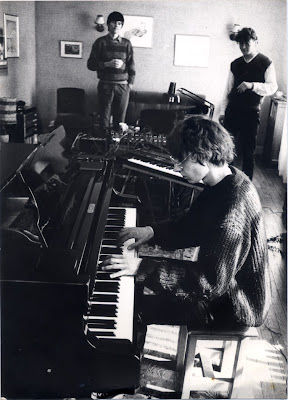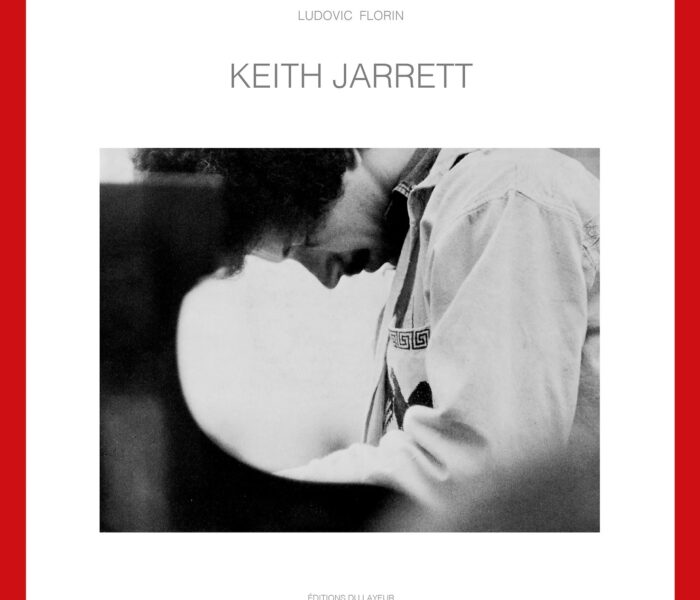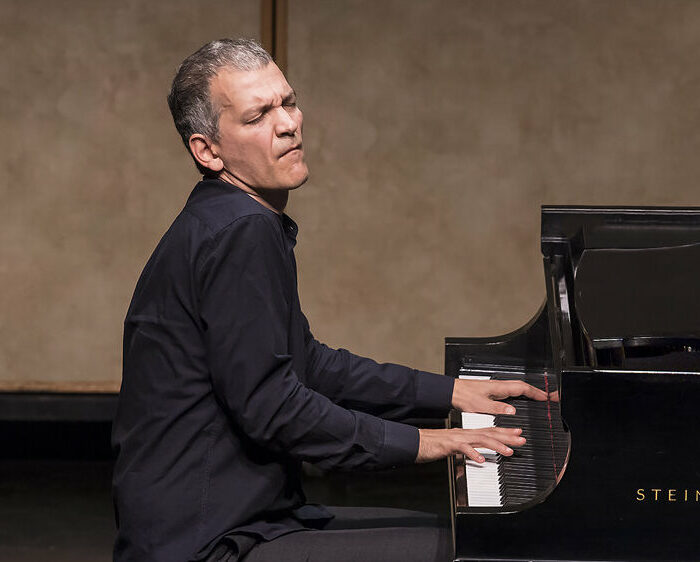Le 23 mai 2020 devait se tenir au Conservatoire à Rayonnement Régional de Boulogne-Billancourt une journée d’hommage au musicien Frédéric Lagnau disparu 10 ans plus tôt. L’occasion de se souvenir d’un musicien représentant un certain french minimalism mâtiné de Satie, de Reich et de rock-progressif. Cet hommage n’a jamais eu lieu comme tout ce qui devait se tenir cette année-là.
En voici un portrait, en forme d’improvisation comme il aurait aimé.
Emporté à l’âge de 43 ans par un cancer en avril 2010 Frédéric Lagnau est un compositeur français qui n’a malheureusement pas encore conquis le coeur des mélomanes (et des musiciens) ; les salles de concerts – frileuses par nature – n’ont pas encore fait la connaissance de son oeuvre foisonnante, plurielle et si touchante. Élève de Louis Andriessen et (durant peu de temps) de Frederic Rzewski (avec qui ce fut houleux), admiré par le compositeur Tom Johnson, pianiste répétiteur à l’opéra Garnier, Frédéric était un compositeur curieux des musiques issues des expérimentations desdits minimalistes (Reich en tête, Adams et Pärt). Rentrer dans l’univers Lagnau demande une ouverture musicale et un grand écart stylistique propres à 2022. Se voulant post-moderne, Frédéric Lagnau est devenu un ultra-contemporain.
Il y a toujours cette petite anecdote liée à l’enfance musicale d’un compositeur qu’il est de bon ton de raconter afin d’illustrer un talent précoce. Dans le cas de Frédéric, rien du singe savant mais plutôt du caméléon sachant: à 5 ans en 1972 il tapote sur le clavier du vieil Érard familial l’hymne à la joie de Beethoven et réclame sans cesse cet instrument qu’il ne sait pas nommer. La fratrie mélomane possède un vinyle du Köln Concert de Keith Jarrett qui fait l’enthousiasme de Frédéric mais ne l’amènera pas vers le jazz, bien au contraire, car c’est le versant expérimental-minimaliste de Jarrett qu’il retiendra. Frédéric sera très tôt attiré vers les aventureux de la musique : Steve Reich, Björk, Henryk Górecki et tous ces inclassables que l’on aime tant réunir sous l’étiquette minimaliste. (Durant sa prime jeunesse, il aura même des échanges épistoliers avec Roger Hodgson – guitariste et claviériste de Supertramp – à qui il enverra des cassettes de sa musique.)
L’exil normand
Deux années chaotiques au CNSM de Paris le feront atterrir rapidement au CRR de Boulogne-Billancourt où il y s’y forgera quelques amitiés éternelles et notamment celle du pianiste Denis Chouillet. C’est là qu’il forge une bonne fois pour toute ses goûts esthétiques et affinités musicales. Selon ses frères (Thierry et François), les premières pièces vraiment composées (et notées sur le papier) de Frédéric datent de ses 15 ans et jusqu’à la fin il ne cessera de composer. Bruno Letort, compositeur et ami de Frédéric raconte : « Il composait tout le temps. Il notait sur tous les supports possibles ses idées. J’ai hébergé ses archives quelques mois, et j’ai pu constater qu’avant d’arriver à une version finale, il travaillait sur de nombreuses versions intermédiaires, jusqu’à l’aboutissement de son idée. Je souhaite à sa musique d’être jouée, enregistrée le plus possible et que l’on « réhabilite » son œuvre, si importante à mes yeux. Elle m’a ouvert l’esprit vers des contrées sonores que je ne connaissais pas. »
Âgé de 18 ans, il part s’isoler dans une ferme normande entouré d’amis et écrit ses premiers chefs-d’oeuvres tels que Journey to Inti (pour deux pianos et un pianiste) ou l’oratorio B-Attitude. Journey to Inti selon Bruno Letort « prend son argument dans la mythologie inca, mythologie qui affirmait l’existence d’un double ou d’un frère spirituel, sorte d’ange-gardien représenté sous la forme d’un faucon, et baptisé Inti. Frédéric, grâce à deux pianos joués par un seul pianiste (photo de couverture), créera ce fameux double, sonore cette fois-ci. » On entend bien évidemment ce que Lagnau doit à Reich mais aussi, tout de suite, une « patte » personnelle, unique et moins systématique que son aîné. Son écriture, plus libre et comme improvisée regorge d’idées et d’effets. À noter, l’aisance pianistique assez sidérante sur deux pianos de Frédéric Lagnau qui le classe parmi les compositeurs capables de jouer leurs musiques les plus virtuoses – la chose se raréfiant au XXème siècle.
C’est également durant son séjour normand qu’il compose son grand oratorio B-attitude pour soprano, quatuor vocal, choeur et percussion (commande du choeur Ars Viva et de la DRAC Haute-Normandie) et créé à Évreux – sa ville natale – le 31 janvier 1993.
« B-attitude est la recherche d’une juste façon de chanter les Béatitudes de la Bible. Une sorte de rituel itinérant au sein du même texte. D’abord visité par les mots, juste les mots, langues, interprétations, presque vides de sens, simples prétextes, conduisant à une inévitable saturation, avant la naissance d’une intelligence qui laisse les mots respirer. […]Car les Béatitudes ne “philosophent” pas ; celui qui reçoit ces paroles les vit, directement, de plain-pied avec toutes les atmosphères qui le composent et qui l’entourent, qu’il compose et qu’il entoure. » Incipit de B-attitude par Frédéric Lagnau.
Un petit film maison suit Frédéric dans sa maison normande en pleine réflexion sur cette oeuvre. On l’entend se questionner et planifier cette pièce qui mériterait aujourd’hui une juste reconnaissance et avant toute chose un bon enregistrement. (La musique des premières minutes du reportage est une de ses pièces majeures pour piano : Ça va son dire).
Le curieux transversal
Ses nombreux amis se souviennent d’un boulimique de musique, avide des compositeurs de son temps et heureux de découvrir toutes leurs recherches esthétiques hybrides que l’on ne trouve pas dans les Conservatoires. L’essayiste Lambert Dousson, son ami avec qui il eut une longue correspondance, se souvient de son « côté très charismatique, riant et parlant fort, hyper cultivé, drôle et déjanté. Il commandait beaucoup de partitions aux Pays-Bas et au Canada et adorait la musique de Louis Andriessen avec qui il avait étudié. On allait ensemble dans les années 1996/1997 écouter les musiques de Reich, Górecki et Pärt à Musica à Strasbourg avant de finir devant une Leffe. C’est grâce au festival « Automne à Varsovie » qu’il découvrit également la musique du Polonais Paweł Szymański qu’il joue sur son second disque « Jardins Cycliques » de 1998. »
Jardins Cycliques est en effet un disque qui réunit les belles découvertes musicales de Frédéric (découvertes plus compliquées à une époque où l’internet balbutiait) mélangées à ses propres oeuvres. On y croise les musiques de son ami Tom Johnson (Les Harmonies d’Euler), la compositrice canadienne Ann Southam, deux pièces du subtil Howard Skempton, Chick Corea s’alternant avec Federico Mompou, Paweł Szymański, Helmut Lachenmann mais aussi Gurdjieff et John Cage. Le tout donne un disque concept bien dans l’air du temps, pluriel mais cohérent. Les pièces se succédent avec une grande logique bien qu’étant parfois séparées de plusieurs siècles. Outre les talents fascinants de pianiste, on y découvre quelques-unes de ses plus belles pièces pour piano : Solar Loops, Les charmes de la marche, Ça va son dire, À mesure et au fur. Pièces conceptuelles, délicates et d’une structure implacable qui paradoxalement le rapproche plus d’un Satie ou d’un Alkan que d’un Reich.
La composition chez Frédéric ne se limitait pas à la musique purement instrumentale. Curieux, il va vers la chanson en compagnie de Nicole Renaud, Élise Caron ou Mona Soyoc et compose quantité de musiques de scène pour le Théâtre National d’Évreux en collaboration avec le metteur en scène Jacques Falguières. Il expérimente même à partir de l’an 2000 la musique de film et de télévision. Exemple de sa versatilité, la bande originale fort réussie (et digne d’un François de Roubaix) d’une série sur France 5, Les Martin.
Le compagnon de route : un entretien avec Denis Chouillet
Dans la galaxie Lagnau, il y a l’ami, le musicien, l’interprète et compositeur Denis Chouillet avec qui il partagea un toit, tant de soirées et tant de musiques durant un certain nombre d’années.
Du 9 au 13 mai prochain, il enregistrera au Centre National de Creation Musicale d’Albi (GMEA) la première monographie consacrée aux oeuvres pour piano de Frédéric. Une première attendue depuis longtemps qui, nous l’espérons, redonnera un élan à cette musique si intelligente et attachante.
Quels sont tes rapports personnels avec Frédéric ?
D’amitié, post-adolescente. De ces amitiés qui expérimentent et forment – si elles ne le font pas toutes ! Mais l’âge compte.
Qu’aimais-tu chez lui ?
Son énergie intarissable, l’allant. Sa curiosité insatiable, sa sensibilité, son humour. Le musicien, bien sûr.
… et que n’aimais-tu pas ?
Son énergie dévorante.
Quelles musiques vous reliaient ?
Beaucoup, diverses. Ce qu’il m’a fait découvrir de très important : Reich et la musique dite “répétitive”, le “jazz ECM”.
Ce que nous avions en commun à notre rencontre : Ligeti, Stockhausen, Xenakis – outre Bach, Ravel, Stravinsky… Nous avons découvert ensemble Arvo Pärt (la Passion, surtout), John Adams (Shaker Loops, surtout), Björk, ou encore – importante – la musique de Tom Johnson. Il m’a fait connaître Jerry Goldsmith et tout un pan de la musique de film. Le GRM, mieux que je ne le connaissais. Supertramp. Et Three Voices de Feldman, par Joan La Barbara, qui a marqué son monde, influencé, voire intimidé sa musique
Comment définirais-tu sa musique ?
Intense, spéculative, poétique, pop. Minimaliste et funky, rêveuse et cyclique.
Comment Frédéric composait ?
Je ne sais pas vraiment, par définition c’est intime. On peut décrire un contexte ou des manifestations, ce que j’ai connu du moins quand nous avons habité ensemble : café, clopes, beaucoup de gamberge partagée, de discussions avant de s’y mettre, et de « monstration » aux proches, à différents stades du travail, même précoces. Il testait beaucoup. En parallèle: un bain constant d’improvisations, souvent enregistrées. Pour autant, le travail de composition lui-même : lucide, exigeant, en témoigne quantité d’esquisses, tableaux, réflexions.
Quelles sont les oeuvres qui te plaisent le plus ?
Dans sa musique en général j’aime l’énergie ; la « bien-sonnance » (son piano sonne ‘large’, même avec peu de notes) ; sa qualité « chamanique », guérisseuse, enjouée, pleine d’influx. J’aime que sa vision à la fois spéculative et poétique soit souvent inscrite dans un cadre temporel entre la chanson et la pièce de clavecin du XVIIème. Me plaît également qu’il ait alterné « thèmes » et « pièces », arrivant parfois à fusionner les « vertus » des deux.
Pour en citer tout de même, pour le piano : les Wind mosaics, A mesure et au fur, Journey to Inti, Les Charmes de la Marche, La gamme qui teinte, Senza vibrato… Dans les thèmes : Morning song, Inner drum, Carrément rondement…
Pour d’autres formations j’aime beaucoup Continuum, Nulle part avant, D’autres yeux sur la même chose, Entre quoi et quoi. Je crois, à la lire, que j’aimerais aussi Le couloir-puzzle (pour deux pianos et deux percussions), si un jour elle était enfin montée.
Qu’as-tu joué avec lui ?
A la maison : quantité d’improvisations et de déchiffrages.
En public : un programme très varié de pièces de Chiel Meijering ou Louis Andriessen, de Mendelsohnn ou d’Antheil, etc. pour le seul concert de quatre-mains que nous ayons donné; le Canto ostinato de Simeon Ten Holt, à deux pianos lors d’une performance nocturne au Théâtre d’Evreux; la musique de scène de David Lang pour AndréAuria d’Edouard Lock au ballet de l’Opéra, toujours à deux pianos ; ainsi que les programmes de l’ensemble Dedalus que nous avons partagés. Nous avons assez longuement travaillé – et réfléchi – sur les Symmetries de Tom Johnson en vue d’un spectacle qui ne s’est jamais réalisé.
Sa musique a-t-elle marqué la tienne ?
Oui! Sachant que je suis moins compositeur que lui (je me définirais plutôt comme un musicien qui compose, improvise, déchiffre ou interprète, à part égale) et bien moins précoce. Maintenant que le temps a passé, il me semble que je m’en rapproche à nouveau, différemment
Que joueras-tu sur le disque que tu lui consacres ?
Des pièces d’élection (citées avant) et d’autres, rangées dans l’ordre chronologique de composition. Je ferais volontiers un double ou un triple album, histoire d’être, sinon exhaustif, du moins plus complet. J’aurais bien tenté de jouer Inti mais la partition a disparu, aussi bizarrement que malheureusement.
Quelles sont les raisons selon toi de la méconnaissance du grand public à son égard ?
In fine on ne sait jamais pourquoi une oeuvre rencontre ou non son public. Toutefois à ce stade la raison est claire ! Le manque de diffusion et la publicité, au sens large. Même si l’on trouve ses deux albums, dont le singulier et réussi Inti, sur le Net. Il faudrait une ou quelques personnes influentes à la manœuvre, une soudaine visibilité dans des lieux ou circonstances médiatisées. Que les snobs trouvent soudain qu’il n’est rien de plus urgent que de connaître ce compositeur méconnu, pour de bonnes ou de mauvaises raisons. Mais aussi qu’elle circule plus dans des milieux jazz, rock indé, pop car je suis sûr qu’elle peut parler à des personnes aux cultures musicales différentes. Elle a cette qualité de synthèse, un côté éloquent et ramassé aussi bien que le caractère « trippant », hypnotique des pièces longues. Et la pulsation, tout comme la répétition, la modalité ou la tonalité, ainsi que le jeu déroutant avec le connu ou le commun qui est une autre de ses vertus communicatives. J’insiste sur cet aspect : le désir de communication, la lisibilité. C’était un esprit délié et exigeant, tenté par l’abstraction, mais, encore une fois, d’essence et de goût joueur, dansant, pop.
Espérons que les disques à venir vont toucher du monde !
Peut-on aller plus loin?
L’association Flag-issimo, créée et tenue par des membres de sa famille « a pour but de faire vivre sa musique, d’aider à la faire connaître en favorisant tous ceux qui l’apprécient et s’y dévouent. L’association se maintient difficilement mais le nombre des adhésions reste malgré tout relativement stable. » se confie François Lagnau, grand frère de Frédéric. Le site rassemble un grand nombre de partitions, médias, photos et textes. Une mine pour tout frédéricolâtre.
Merci à Denis Chouillet, François et Thierry Lagnau, Bruno Letort et Lambert Dousson pour leur aide.
François Mardirossian



)









